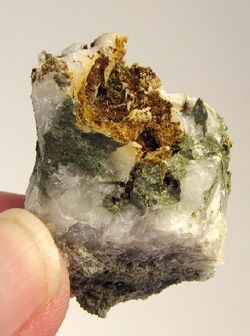Chemistry:Trogtalite
| Trogtalite | |
|---|---|
 Piece of oosterboschite with cuprosklodowskite, quartz, and brown oxidized trogtalite from the Musonoi mine. From the Howard Belsky collection. | |
| General | |
| Category | Selenide minerals |
| Formula (repeating unit) | CoSe2 |
| Strunz classification | 2.EB.05a |
| Dana classification | 2.12.1.5 |
| Crystal system | Cubic |
| Crystal class | Diploidal (m3) H-M symbol: (2/m 3) |
| Space group | Pa3 |
| Identification | |
| Color | Rose-violet |
| Crystal habit | Irregular grains |
| Mohs scale hardness | 3.5–5.5 |
| |re|er}} | Metallic |
| Diaphaneity | Opaque |
| Density | 7.12 (calculated) 7.09 (synthetic) |
| Pleochroism | None |
| Ultraviolet fluorescence | None |
| Solubility | Insoluble |
| Common impurities | Cu, Pd |
| References | [1][2][3] |
Trogtalite is a rare selenide mineral with the formula CoSe2. It crystallizes in the cubic system and is part of the pyrite group, consisting of Co2+ and Se22− ions. It has a rose-violet colour and its crystals are opaque.[2] It often occurs as grains. It was thought to be dimorphous with hastite, but this was discredited in 2009.[3] Hastite turned out to be the iron selenide mineral ferroselite.[4] It forms a solid solution series with kruťaite.
Occurrence
Trogtalite was first found in 1955 in Trogtal quarry, Lautenthal, Harz Mountains, Germany, after which it was also named. It often occurs intergrown with clausthalite grains at this locality. It has also been found in the Musonoi Cu–Co mine, Kolwezi, Katanga Province, Congo and in Argentina, in Tuminico, Sierra de Cacho, and in Los Llantenes, La Rioja Province. It is often found together with clausthalite, ferroselite, bornhardtite, native selenium, gold, and oosterboschite.[5]
See also
References
- ↑ Warr, L.N. (2021). "IMA–CNMNC approved mineral symbols". Mineralogical Magazine 85 (3): 291–320. doi:10.1180/mgm.2021.43. Bibcode: 2021MinM...85..291W.
- ↑ "Trogtalite: Trogtalite mineral information and data.". http://www.mindat.org/min-4028.html.
- ↑ Frank N. Keutsch, Hans-Jürgen Förster, Chris J. Stanley, Dieter Rhede (September 11, 2009). "The discreditation of hastite, the orthorhombic dimorph of CoSe2, and observations on trogtalite, cubic CoSe2, from the type locality.". Canadian Mineralogist 47 (4): 969–976. doi:10.3749/canmin.47.4.969. http://canmin.geoscienceworld.org/content/47/4/969.
- ↑ "Hastite: Hastite mineral information and data.". http://www.mindat.org/min-1825.html.
- ↑ "Handbook of mineralogy, trogtalite". http://www.handbookofmineralogy.org/pdfs/trogtalite.pdf.
 |

